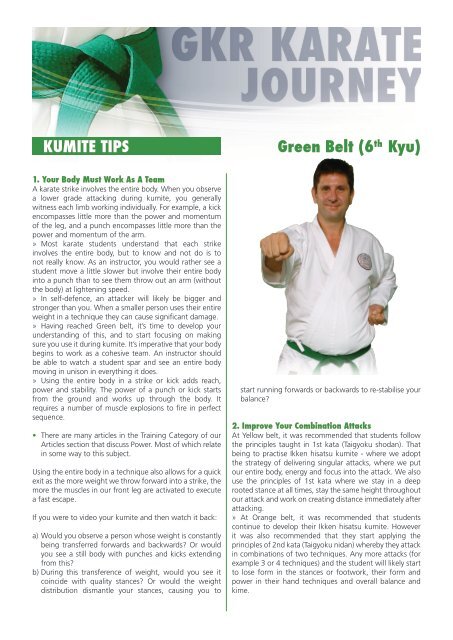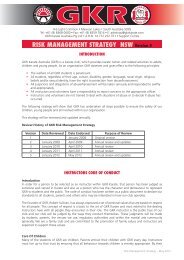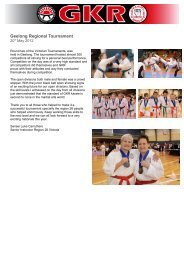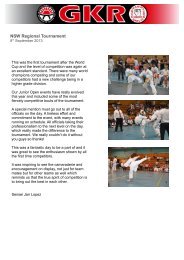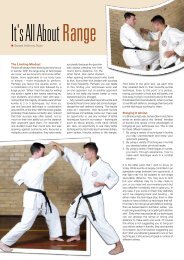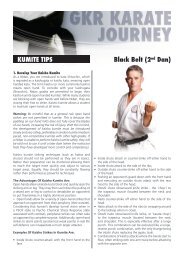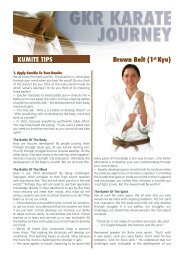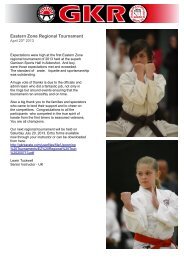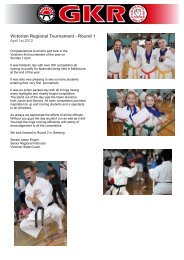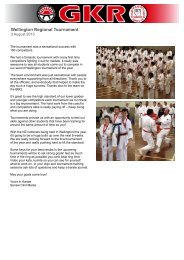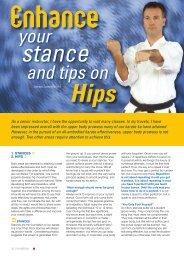Green Kumite Fact Sh.. - GKR Karate
Green Kumite Fact Sh.. - GKR Karate
Green Kumite Fact Sh.. - GKR Karate
You also want an ePaper? Increase the reach of your titles
YUMPU automatically turns print PDFs into web optimized ePapers that Google loves.
<strong>Kumite</strong> Tips<br />
<strong>Green</strong> Belt (6 th Kyu)<br />
1. Your Body Must Work As A Team<br />
A karate strike involves the entire body. When you observe<br />
a lower grade attacking during kumite, you generally<br />
witness each limb working individually. For example, a kick<br />
encompasses little more than the power and momentum<br />
of the leg, and a punch encompasses little more than the<br />
power and momentum of the arm.<br />
» Most karate students understand that each strike<br />
involves the entire body, but to know and not do is to<br />
not really know. As an instructor, you would rather see a<br />
student move a little slower but involve their entire body<br />
into a punch than to see them throw out an arm (without<br />
the body) at lightening speed.<br />
» In self-defence, an attacker will likely be bigger and<br />
stronger than you. When a smaller person uses their entire<br />
weight in a technique they can cause significant damage.<br />
» Having reached <strong>Green</strong> belt, it’s time to develop your<br />
understanding of this, and to start focusing on making<br />
sure you use it during kumite. It’s imperative that your body<br />
begins to work as a cohesive team. An instructor should<br />
be able to watch a student spar and see an entire body<br />
moving in unison in everything it does.<br />
» Using the entire body in a strike or kick adds reach,<br />
power and stability. The power of a punch or kick starts<br />
from the ground and works up through the body. It<br />
requires a number of muscle explosions to fire in perfect<br />
sequence.<br />
• There are many articles in the Training Category of our<br />
Articles section that discuss Power. Most of which relate<br />
in some way to this subject.<br />
Using the entire body in a technique also allows for a quick<br />
exit as the more weight we throw forward into a strike, the<br />
more the muscles in our front leg are activated to execute<br />
a fast escape.<br />
If you were to video your kumite and then watch it back:<br />
a) Would you observe a person whose weight is constantly<br />
being transferred forwards and backwards? Or would<br />
you see a still body with punches and kicks extending<br />
from this?<br />
b) During this transference of weight, would you see it<br />
coincide with quality stances? Or would the weight<br />
distribution dismantle your stances, causing you to<br />
start running forwards or backwards to re-stabilise your<br />
balance?<br />
2. Improve Your Combination Attacks<br />
At Yellow belt, it was recommended that students follow<br />
the principles taught in 1st kata (Taigyoku shodan). That<br />
being to practise Ikken hisatsu kumite - where we adopt<br />
the strategy of delivering singular attacks, where we put<br />
our entire body, energy and focus into the attack. We also<br />
use the principles of 1st kata where we stay in a deep<br />
rooted stance at all times, stay the same height throughout<br />
our attack and work on creating distance immediately after<br />
attacking.<br />
» At Orange belt, it was recommended that students<br />
continue to develop their Ikken hisatsu kumite. However<br />
it was also recommended that they start applying the<br />
principles of 2nd kata (Taigyoku nidan) whereby they attack<br />
in combinations of two techniques. Any more attacks (for<br />
example 3 or 4 techniques) and the student will likely start<br />
to lose form in the stances or footwork, their form and<br />
power in their hand techniques and overall balance and<br />
kime.
» At <strong>Green</strong> belt level, it’s still recommended that you<br />
continue to keep your combination attacks to a minimum<br />
(two techniques at most). You may throw the odd attack<br />
of three or four techniques, but the majority of techniques<br />
should be singular or double techniques. You should be<br />
practising double attacks more frequently than when you<br />
were an Orange belt.<br />
» Having achieved <strong>Green</strong> belt, it’s likely that your double<br />
attacks (eg throwing two hands strikes or a hand and foot<br />
combination) do still find you compromising in either form,<br />
stances, footwork, balance, zanshin etc. Before you start<br />
to develop multiple attack combinations you want to feel<br />
safe and secure that you don’t compromise anything on a<br />
double attack. In essence we want to walk before we can<br />
run.<br />
» You must appreciate that while multiple attacks in<br />
kumite (chasing an opponent across the dojo) may appear<br />
impressive, a real life attacker will hardly run away. By<br />
contrast they will likely be right in your face. Therefore<br />
your best attacks will be singular attacks or double attacks.<br />
And as stated many times, if you throw multiple attacks<br />
on the spot then it means you have engaged in toe-totoe<br />
sparring, and this is unwise against a larger, stronger<br />
opponent.<br />
If you find that you cannot reach your opponent unless you<br />
unleash a flurry of hand attacks (eg 3, 4 or more) then it<br />
implies you are falling down in one of these areas:<br />
a) Footwork. You are likely running in (running uses small<br />
steps) rather than using footwork. Proper footwork<br />
(moving from one quality stance to another) covers far<br />
more distance and in a much shorter time frame.<br />
b) You are not striking in stance. While footwork focuses<br />
on moving through in stances, striking in stance only<br />
focuses on the stances we use upon striking. One reason<br />
why students fall short (thus having to chase after their<br />
opponent) is that they strike in a very short stance. Like<br />
1st kata, our strikes should be hitting the target while we<br />
land in a long forward like stance. It doesn’t have to be<br />
a picture perfect long forward stance, but the principles<br />
the stance promotes should exist. These include being<br />
two shoulder widths long, the front knee over the front<br />
foot and the hips square (for a reverse punch). These all<br />
add greater reach and power.<br />
c) You are telegraphing your intentions. If it is obvious to<br />
your opponent that you are about to attack, they will<br />
edge backwards, requiring you to cover more ground to<br />
reach them. Instead of chasing them down, postpone<br />
your attack and focus on minimising your telegraphing<br />
next time. Examples of telegraph are:<br />
i) The Head - Clenching the teeth, closing the mouth,<br />
taking a deep breath, narrowing the eyes or tilting<br />
the head forward. The face should remain calm at all<br />
times during kumite.<br />
ii) The Arms - Closing one or both of the hands, moving<br />
the guard to a more attacking posture, pulling the<br />
front hand back closer to the body or tensing up the<br />
arms.<br />
iii) The Legs - Lowering in stance, raising in stance,<br />
shortening the stance, altering the angles of the feet,<br />
adding a bounce or ceasing bouncing. Many students<br />
wind up their attack before they commit to a strike,<br />
so this is an obvious one to look for.<br />
iv) Strategy - If you are predictable in your strategy then<br />
your opponent will always be one step ahead of you.<br />
For example, if you always throw a reverse punch<br />
followed by a front kick, they will prepare for this.<br />
d) You are starting your attacks from poor distance. If<br />
you start too far away your opponent will have too<br />
much reaction time. If they are an advanced karateka<br />
they will take advantage of this and score on you<br />
(you won’t get a combination attack off). If they are not<br />
experienced they will back away leaving you unable to<br />
score unless you go after them. Rather than going after<br />
them, postpone your attack and focus on starting from<br />
a perfect distance next time.<br />
3. Opening The Rear Hand<br />
You were permitted (if you chose) to start opening the<br />
front hand of your guard at Orange belt. Having achieved<br />
<strong>Green</strong> belt you may open your rear hand if you choose.<br />
This implies that you should be versed enough in combat<br />
too, if you have an open hand, close the fist and shape the<br />
wrist correctly in a very short period of time should you<br />
chose to strike from guard.<br />
4. Improve Your Counter-Attacks<br />
The benefits and importance of the counter-attack was<br />
listed in the Orange belt section of ‘The Journey’. Be sure<br />
to visit the Orange belt section if you would like to read<br />
about this.<br />
» In short, it’s most likely that in a real life confrontation<br />
that the attacker will throw the first strike. When this<br />
happens a defender has three options.<br />
a) Block and do nothing. This will put the attacker in good<br />
stead to launch a follow up technique.<br />
b) Retreat, evade or side-step. While this creates distance<br />
for us to live to fight another day (which will likely occur<br />
in a matter of seconds), it also makes our opponent<br />
aware of our skills; hence they may adapt their tactics.<br />
c) Block and counter. A person is never more open<br />
and vulnerable than when they are in the process of<br />
attacking. Their ‘T’ line (our most vulnerable areas are<br />
found in an area resembling a capital ‘T’: our temples,<br />
eyes, nose, mouth, chin, throat, solar plexus and groin)<br />
are all exposed, as are the floating ribs, knees etc.<br />
Furthermore, because our focus is on striking rather<br />
than defending, receiving a blow affects us mentally as<br />
much as physically.<br />
Because of the importance the counter-attack plays in<br />
self-defence, it should start to become a major focus in<br />
your kumite journey. To score a successful counter attack a<br />
student needs the following:
i) Maintaining a well-balanced stance. This does not imply<br />
you must stand your ground and block. In fact, where<br />
an opponent is larger and heavier, it is wise to shift<br />
your stance either back or on an angle as you block.<br />
This serves to either absorb some of their energy or so<br />
their weapon (the foot or hand) has extended beyond<br />
its ideal power area. As you become more proficient<br />
you may even move forward as you block to snuff out<br />
their technique before it builds full momentum.<br />
What this point does imply is one of the following:<br />
While you are moving in your stance, you do not compromise<br />
the quality of the stance. Both feet should slide evenly into<br />
their new position; hence the stance still maintains the<br />
same proportions, strengths, balance etc.<br />
While you are moving in stance, you may choose to move<br />
from one stance to a different one. In other words, only<br />
one foot might slide (eg the front foot slides back to a<br />
stance similar to Cat stance). But as you transition yourself<br />
from one stance to another, you don’t lose your posture,<br />
balance etc.<br />
ii) Use ‘economy of movement’. In combat, nanoseconds<br />
count. Therefore any excess movement needs<br />
to be culled. This is why it’s often said that the further<br />
one travels in their karate journey that it becomes as<br />
much about culling as it does about adding. Examples<br />
of people using excess movements are:<br />
Over blocking. For a block to be effective it often requires<br />
only the smallest of movements. Over blocking may<br />
still be successful against the attack but it leaves you<br />
exposed for a follow up technique. Beyond this it reduces<br />
your opportunity to counter strike and can leave you to<br />
unbalanced to counter strike.<br />
» Over preparing your strike. During Kihon (basics) we<br />
often practise bringing our striking hand to our floating<br />
ribs prior to striking. During kumite (especially for <strong>Green</strong><br />
belt and above) we should have the ability execute a quality<br />
strike directly from our guard position. Students often make<br />
the mistake of blocking, and then preparing their hand at<br />
their floating ribs prior to launching their counter-strike.<br />
This takes up time you don’t have!<br />
» Anticipation strikes (like the pick off) are not suggested<br />
at Orange belt because they are highly advanced<br />
techniques that rely on precise timing and shifting of the<br />
body weight.<br />
5. Develop Your Defensive Zanshin<br />
At Orange belt we introduced you to the awareness of<br />
developing your zanshin (continued state of awareness)<br />
when you are attacking. Having reached <strong>Green</strong> belt it’s<br />
important to start honing your defensive zanshin.<br />
Examples of a student who lacks defensive zanshin are:<br />
a) Turning the head away from the attacker. This ‘flinching’<br />
movement is simply a subconscious reaction that can be<br />
eliminated over time.<br />
b) Closing the eyes while defending. This is another<br />
subconscious reaction that can be eliminated over<br />
time.<br />
c) Ducking the head (to a foetal position): The foetal<br />
position is instinctive to every human being. You<br />
don’t have to train someone to go into ‘full protective<br />
mode’. We naturally revert to it because it protects<br />
our vulnerable areas and has a subconscious feeling of<br />
safety associated with it. Even an advanced karate-ka<br />
may occasionally find themselves naturally reverting to<br />
this defensive position. The key is however, that once<br />
there, you do something rather than stay there.<br />
d) Giving up once scored upon. Many students try to block<br />
but once scored upon, immediately ‘switch off’. They<br />
give up, dropping their hands and coming out of their<br />
stance. You must understand that in real life self-defence<br />
you may be struck (and struck hard) but that does not<br />
mean it’s over. You have to keep fighting on.<br />
The key is to try your best to defend. And if scored upon<br />
(even multiple times) to keep defending until your opponent<br />
stops and moves away. At this point in time (signalling the<br />
end of that engagement) you can bow and start again.<br />
e) Coming out of stance. This was mentioned in the point<br />
above, but it does not solely occur when a student gives<br />
up. It’s another natural reaction. Students might tell<br />
themselves over and over to stay in stance but each time<br />
they find their subconscious takes over and they come<br />
out of stance.<br />
In terms of self-defence, you need to train yourself to stay<br />
in stance. This will ensure any attacks you make have power<br />
and reach. It will also enable you to withstand pressure (eg<br />
by way of a tackle).<br />
Some might argue that defensive zanshin is more important<br />
that offensive and should come first. The reason it has not<br />
is because of the natural progression most students go<br />
through with their defence. This includes:<br />
i) Initially, the student will back away and retreat<br />
whenever their opponent attacks (this is most often<br />
a subconscious response to an attack as the student<br />
does not feel confident in their blocking ability).<br />
ii) Understanding the importance of blocking in selfdefence,<br />
they start to remind themselves to hold<br />
their ground and try to block. This is a period of<br />
trial and error and they may often find themselves<br />
overwhelmed (both physically and emotionally). This<br />
results in them often ducking their head or turning<br />
their head to face away from their opponent. This<br />
‘flinching’ is perfectly natural and a subconscious<br />
reaction.<br />
iii) Over time they learn to hold their stance and block<br />
competently. When this occurs they can start to apply<br />
focus to minimal stance shifting whilst blocking and<br />
their zanshin. To expect it too early will only cause<br />
frustration for the student.
Having reached your <strong>Green</strong> belt, your defensive skills<br />
should be a part instinctive reaction. This means that whilst<br />
blocking your mind is free to think of other things. One of<br />
these includes defensive zanshin.<br />
» As you develop throughout your kumite journey you<br />
will find that other principles become instinctive (such as<br />
footwork, stances, counter-attacking, multiple attacks etc).<br />
The more these technical areas become instinctive the more<br />
you can work on overcoming natural emotional reactions<br />
(such as ducking, turning the head etc).<br />
6. Develop Your Ikimi And Itsoku<br />
Now you are a <strong>Green</strong> belt, you have most likely developed<br />
a few favoured attacks for kumite. Your goal will often be<br />
to execute these quickly. Two vital ingredients required for<br />
any attack are Ikimi and Itsoku:<br />
Ikimi is the principle of floating. When you are in the process<br />
of attacking, you should avoid any excess tension in your<br />
body. This applies especially to the legs. They should move<br />
through light and swift as though floating.<br />
» Itsoku is the principle of being glued to the floor. The<br />
moment you make contact with the ground (and punch)<br />
you should adopt itsoku. This ensures you land in a rock<br />
solid stance. This will not only add enormous power to your<br />
strike it will give you a greater ability to change directions<br />
immediately after striking. Finally, it will make it much<br />
harder for your opponent to unbalance you (either through<br />
the process of blocking, sweeping, pulling, tackling etc).<br />
Many karate-ka make the habit of adopting only one<br />
principle.<br />
» Some are forever too tense in their kumite. While this<br />
serves them well when they are defending or the moment<br />
they land after an attack, it hinders their speed and power<br />
because tension slows the body down. The equation for<br />
Power is ‘P=M+V’, meaning, Power is derived from Mass<br />
times Velocity. Therefore to have your body slowed down<br />
by excess tension equals less power.<br />
For their opponents in kumite, while they are strong, their<br />
lack of speed means they are easier to retreat from, easier<br />
to counter-attack and they lack agility.<br />
» Some students are forever too relaxed in their kumite.<br />
While they will generally move with speed and agility, they<br />
never really add kime (the focus or harnessing of ones<br />
energy into a single moment) into any of their strikes or<br />
kicks. What’s more they are easy to counter strike and<br />
overbalance. If you ever attack and find yourself unable<br />
to stop yourself from travelling forwards after you have<br />
finished, then it implies you have too much ikimi and not<br />
enough itsoku.<br />
» Balancing these two principles is part of the life-long<br />
journey of karate. Your time to start focusing on this is<br />
now.<br />
» There is an enormous side benefit to developing your<br />
ikimi and itsoku. Your kata and basic combinations when<br />
moving through in stances will improve greatly.<br />
7. Understanding The Importance Of The Bow<br />
During <strong>Kumite</strong><br />
By now your kumite ability would be coming along nicely<br />
and as such, with techniques becoming more instinctive,<br />
perhaps your focus has started to see kumite somewhat<br />
as competition. While there is nothing wrong with being<br />
competitive in kumite, a common pitfall among competitive<br />
students is that they often neglect to bow to their opponent<br />
when scored upon. And with the risk of stereotyping, it is<br />
often larger men that choose not to bow when a smaller<br />
framed person successfully lands a technique on them.<br />
Perhaps it’s ruled by ego, perhaps the desire to win so badly<br />
clouds their judgement, or perhaps even their mindset is,<br />
“well that wouldn’t have hurt me in real life anyway.”<br />
Ultimately, the more competitive we become the more<br />
emphasis we must place on the importance of the bow.<br />
This is because the bowing to our opponent whenever<br />
they score extends beyond etiquette.<br />
Values of the Bow are:<br />
The act of stopping and bowing to your opponent serves<br />
as a reality check. The very process gives you time to think<br />
about the fact that your defences were not up to scratch<br />
(inspiring you to work harder). It also sends you a message<br />
that your strategy was unsuccessful, giving you a brief<br />
second or two to think up a new strategy (remember, the<br />
definition of frustration is to do the same thing over and<br />
over yet expecting a different result). It matters not that<br />
a much smaller person may not have hurt you with their<br />
strike in real life, because what if they struck you with a<br />
knife? You stopping to bow is not about your opponent<br />
and their abilities, it is about you and accepting your lack<br />
of abilities to inspire you to become better. If we refuse to<br />
accept our shortcomings we will never grow.<br />
» Understanding the importance of the bow is just the<br />
first step. The second step is to understand how and when<br />
it should be done. Be sure to visit our Articles archive and<br />
click on the ‘Self-Defence’ icon in our ‘Training’ articles.<br />
Here you will find an enlightening article titled ‘Even Our<br />
Bow Prepares Us For Self-Defence’.<br />
8. Avoid Toe-to-toe Sparring<br />
Avoiding toe-to-toe combat has been discussed a number<br />
of times in the kata section of each belt grade. Considering<br />
kata is designed to teach principles and techniques for<br />
real life self-defence, we should adhere to these during<br />
kumite.<br />
» It’s common to see students standing toe-to-toe and<br />
slugging it out. This is where kumite becomes a sport.<br />
While it does help develop our reactions and coordination,<br />
<strong>Green</strong> belt is not the time to do this. This is because we<br />
are still creating sparring habits and this is the last habit we<br />
want to instil.<br />
» If a person should attack you in real life, they will likely<br />
be much bigger than you so you don’t want a habit of
standing right in front of them for an extended period. Be<br />
sure to continue working on your kata principles, which<br />
involve getting in and out (cause damage and then move<br />
to safe distance to asses), or breaking the line after an<br />
attack.<br />
9. Control Your Self-Talk<br />
<strong>Karate</strong> is a pursuit of both body and mind. As a lower<br />
grade you have so much to think about during kumite<br />
(from a technical perspective) that there is literally no room<br />
for much else. Having reached <strong>Green</strong> belt and a degree of<br />
unconscious competence (to do something well without<br />
having to think about it) you have room in your mind for<br />
other things.<br />
» While you have plenty of new techniques, strategies and<br />
principles to work on, don’t forget to think about your selftalk.<br />
You may not realise this but you are talking to yourself<br />
24 hours a day. Because of this, the biggest hurdle anyone<br />
faces when trying to be a success at any endeavour is their<br />
own self-talk. It can lift us up or drag us down.<br />
» Because we are talking to ourselves 24 hours a day,<br />
it means we are talking to ourselves constantly during<br />
kumite. And our self-talk during kumite affects our success<br />
as much as any other aspect of karate.<br />
The following are examples of things students might say to<br />
themselves to detract from their ability:<br />
a) “They are too fast,” “They are too experienced,” “They<br />
are too big,” “They are too strong” etc. Students might<br />
even say more than one of these! Humans only have<br />
the ability to really focus on one thing at any given time.<br />
So if we are focused on our opponent’s advantages,<br />
we are too preoccupied to start looking for our own<br />
advantages.<br />
b) “I’m too old,” “I’m too slow” etc. This is very similar<br />
to the above, however rather than focusing on our<br />
opponent’s strengths we are focusing on our own<br />
weaknesses. A better way to talk to yourself might be,<br />
“Ok they are big and strong. But they aren’t so mobile.”<br />
This self talk will trigger a new strategy. People who are<br />
big and strong are used to people just standing there<br />
like sitting ducks.<br />
c) “What’s the point of attacking, they will just block me<br />
and counter attack.” The worst thing about this is that<br />
we end up attacking and they really do end up blocking<br />
and counter attacking. But does that mean we were<br />
right all along? Possibly. But the problem is when we are<br />
worried with these thoughts, they transcend into our<br />
body. The result is we telegraph more, move slower, fail<br />
to set up our attack properly, start from poor distance<br />
etc.<br />
A better way to talk to yourself would be. “Ok, so they<br />
have good counter attacking. So I need to make sure I stay<br />
relaxed, get to perfect distance, don’t telegraph, stay low,<br />
and commit to my technique.” In short, focus on solutions,<br />
not problems.<br />
Next time you spar, take a moment to listen to your selftalk:<br />
• Does it portray a defeatist attitude?<br />
• Does it cause you to hesitate?<br />
• Does it destroy your self-confidence?<br />
• Does it portray your opponent in far too positive a<br />
light?<br />
If you answered yes to any of the above, it’s time to start<br />
developing your self-talk. And as karate is a Way of Life,<br />
you can do the exact same exercise in other areas of your<br />
life. The way you talk to yourself at school, or in exams, or<br />
at work, at home, in your relationships etc.<br />
10. Feinting With Hand Techniques<br />
We have not recommended feinting (pretending to strike)<br />
prior to <strong>Green</strong> belt because, as a lower grade it’s important<br />
to make a decision to attack and commit to it. This will<br />
help a person refine their technique and distance.<br />
» Beyond this, when a lower grade feints they often do it<br />
very poorly and end up getting themselves into trouble.<br />
» That said, any grade can and should feint (or fake)<br />
during kumite. However, at <strong>Green</strong> belt we can start to<br />
really develop our feinting skills.<br />
There are two types of feinting hand strategies.<br />
i) Start and Stop: The start and stop feint involves<br />
stepping the front foot out quickly (but only a slight<br />
distance) and executing the first part of the hand<br />
technique. Then quickly bringing the front foot back<br />
to fighting stance again. In essence, you start your<br />
attack and then stop, immediately retreating back<br />
to your fighting stance. This strategy serves two<br />
purposes:<br />
a) It allows you to assess your opponent’s reactions. For<br />
example, if you fake to attack and your opponent backs<br />
away, then you can assess that when you attack, you<br />
should look to cover plenty of ground and commit to<br />
more than one strike if necessary.<br />
If however they throw a punch, you can assess that they are<br />
poised to strike the moment you strike (the Japanese term<br />
for this is ‘Sen-no-sen’). This will help you adopt a different<br />
strategy, such as to fake and then strike immediately after<br />
they throw a premature strike.<br />
b) It puts their focus on you. We are never at our best<br />
when our focus is on our opponent. The famous boxer,<br />
Mohammed Ali, used this tactic successfully throughout<br />
his career. Not so much in the ring, but in his talk<br />
leading up to a bout. His opponent spent most of their<br />
time thinking about Ali rather than their own training,<br />
strategies etc.<br />
Whenever our opponent feints in a realistic fashion, our<br />
thoughts are disrupted by the urgent need to respond. In
other words, if you feint often you continue to disrupt the<br />
thoughts of your opponent, as their focus shifts to you and<br />
your potential strategy rather than their own.<br />
ii) Start And Change: There is no better way to reduce<br />
your opponent’s confidence than to offer them no<br />
obvious openings. When an opponent does not have<br />
a target to focus on (due to an excellent guard) they<br />
will hesitate and withdraw. If you come up against<br />
an opponent whose guard offers no openings, rather<br />
than lose confidence you can create openings by<br />
applying the start and change feint technique.<br />
The start and change feint involves stepping the front foot<br />
out quickly (but only a slight distance) and executing the<br />
first part of the hand technique, then quickly changing the<br />
technique completely, directing the strike to a different<br />
area of the body. When you change your attack you may<br />
use the same arm or use the opposite arm. For example,<br />
feint to jab (lunge) low and then change up and jab head<br />
level with the same hand, or feint to jab (lunge) to the<br />
head and then use your other hand to reverse punch low.<br />
» This strategy is designed to open up a target area. When<br />
you cannot see an opening in an opponents guard, your<br />
best plan is to feint to one area, drawing your opponent’s<br />
attention and guard to one area of their body (opening up<br />
another area).<br />
» In the famous martial arts book ‘The Thirty-Six<br />
Strategems’ it reads, “Make a sound in the east, then<br />
strike in the west. In any battle the element of surprise<br />
can provide an overwhelming advantage. Even when face<br />
to face with an enemy, surprise can still be employed by<br />
attacking where he least expects it. To do this you must<br />
create an expectation in the enemy’s mind through the<br />
use of a feint. The idea here is to get the enemy to focus<br />
his forces in a location, and then attack elsewhere which<br />
would be weakly defended.” This principle is often credited<br />
to Sun Tzu (author of the Book of War) but texts of this<br />
existed 150 years prior to his birth. (On a side note, Sun<br />
Tzu discussed a similar idea but in relation to fire).<br />
» The most important part of a feint is that it is realistic.<br />
Throwing a hand out is not believable. <strong>Sh</strong>ifting the entire<br />
body (even sliding a foot out and back) with the hand<br />
will likely cause your opponent to truly react. Practice a<br />
technique slowly and feel the movements. Then complete<br />
the technique halfway a few times. After this, complete it<br />
again only go out one third of the way. This is what your<br />
feint should involve - the exact movements of the technique<br />
one third of the way out.<br />
» For <strong>Green</strong> belt we recommended you start developing<br />
your feinting with hand techniques. We do not suggest<br />
you start feinting with leg techniques as an inexperience<br />
karate-ka will often bring themselves undone feinting<br />
with kicks. This is because they find themselves in a poor<br />
position (poor stance, balance, distance etc). At <strong>Green</strong> belt<br />
a student should allow their kicks to come out truly to<br />
develop their technique. This does not mean a <strong>Green</strong> belt<br />
cannot feint with kicks, these tips are merely suggestions<br />
for your kumite journey.


